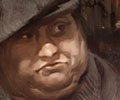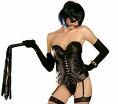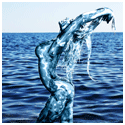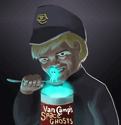|
A quick google search brought this up: http://www.wetcanvas.com/forums/showthread.php?t=170002 yes, there is a difference between cheap primer paint and gesso. Gesso will last longer, and age better, than primer but I think the real test would be to see how it feels to paint on. Also, keep in mind that most house paints are specifically designed to repel oil and pigments so as not to muck up the pretty colors, so your primer might not let you work on it in oil pastels. Or it could end up really cool, I'd at least try it and see how it works, just don't expect it to be in a museum in several hundred years (not because it's bad art, but because it rotted away).
|
|
|
|

|
| # ? Apr 26, 2024 18:14 |
|
I just painted it on some cheap paper to see how it will work. I'm letting it dry now. Here's another question. How thick of a layer do you want when gessoing paper? I may have put too much because the paper got really warped with the moisture. Granted it was thinner paper.
|
|
|
|
I have two questions about manuscript format. First, what do three number signs # # # signify in a manuscript? Second, I want to have chapters but I don't want them to be numbered or titled. I want the book to have a simple repeated image at the top corner of each new chapter, but I'd settle for the first letter of each chapter being large, like a storybook. I realize I'm getting ahead of myself but how should I format this in the manuscript? Should I just start on a new page for a new chapter with nothing else to signify that it is in fact a new chapter?
|
|
|
|
Fantasmo posted:I have two questions about manuscript format. Three number signs or three asterisks (* * *) usually designate a chapter break. Use that, centered on the page. And don't breathe a word of your fancy formatting ideas until that book is sold.
|
|
|
|
Thanks, Slashie! To be clear, should I use the #'s and then start a new page or just have it continuous?
|
|
|
|
Fantasmo posted:Thanks, Slashie! Give them their own line (you are double-spacing, right?) and then just keep on going. Like: code:
|
|
|
|
I'm about to put some paint down on an oil painting. The paint's at least a week dry. Do I really need to use the special artist tape, or can I use regular masking tape?
|
|
|
|
Elijya posted:I'm about to put some paint down on an oil painting. The paint's at least a week dry. Do I really need to use the special artist tape, or can I use regular masking tape? Did you paint the original layer? If so, what was your mixture of linseed/thinner? If it was a thin layer, I'd say it would be okay, depending again on how much tape you are using/ how big a space it is. If it's a thick, globby layer, then no. It's really hard to tell unless you describe the situation more.
|
|
|
|
plaguedoctor posted:Did you paint the original layer? If so, what was your mixture of linseed/thinner? If it was a thin layer, I'd say it would be okay, depending again on how much tape you are using/ how big a space it is. Sorry. Yes, I painted the original layer. A fair amount of turp went into it, so the paint is not thick at all.
|
|
|
|
Elijya posted:Sorry. Yes, I painted the original layer. A fair amount of turp went into it, so the paint is not thick at all. Touch it with your finger in an inconspicuous spot. If it's still tacky at all, I'd not put tape on it. If it feels slick/shiny at all, it should be okay. Of course, be careful and don't press the tape down too hard. If it's cheap/non-sticky masking tape, it should be okay, but anything more than that might take the paint up as well. We don't have the painting here in front of us, so it's pretty much up to to your judgement at this point, though.
|
|
|
|
Yeah, but I have no experience, so my judgement isn't very good  I'm sure the paint is dry enough - I already used artist tape on it over a week ago. I was more asking if masking tape is really that much different from artist tape. Thank you though. I'm sure the paint is dry enough - I already used artist tape on it over a week ago. I was more asking if masking tape is really that much different from artist tape. Thank you though.
|
|
|
|
Elijya posted:Yeah, but I have no experience, so my judgement isn't very good Yes, masking tape is generally a lot more tacky than artist tape. If you don't have any artist tape, painter's tape may work similarly. I don't do taping, so I'm not sure though.
|
|
|
|
Question about keeping proportion/perspective correct when working large, specifically with oil paints. I haven't painted seriously in almost 5 years, but a coworker asked if she could display some old pieces for a random project and now I have 4 pieces commissioned. All of them will be (in terms of dimension) several times larger than the biggest finished piece I've ever done. The smallest is looking like it'll be 48"x60". I took them because I'm certain I can do it, but I'm worried that my sense of perspective and size will get skewed when I'm working on something that's bigger than I am. The first thought is to draft everything small and then grid, but if someone else has a better way to do it or can talk about other techniques they use it'd be helpful. Specifically I'm worried about a particular painting, which is a door opening inward and the scene behind it. The geometry of a half-open door seems like it'd be really easy to screw up, and with a canvas that large anything quirky about it will be really easily noticeable.
|
|
|
|
I swear in Illustrator the little black arrow used to let me drag things around and resize them by default, but now it only seems to let me drag things around, and if I want to resize I need to switch to the resize tool. This sucks because if I want to select something else I need to switch back to the arrow. Someone please tell me I'm not going mad and I've accidentally turned off some option by mistake.
|
|
|
|
Question about GIMP. Im trying to find a plugin of somesort Similar to Fisheye Hemi for photoshop. Whereas it will take my fisheye shots and "de-fishify" them. I have tried different ways of doing this Using Capture NX, and other software that claims to work the same, but everything gives me poor quality. Ive even gone through and used distortion fix on it but i lose 50% of the photo.
|
|
|
|
zap actionsdower! posted:Yes, masking tape is generally a lot more tacky than artist tape. If you don't have any artist tape, painter's tape may work similarly. I don't do taping, so I'm not sure though. Just FYI, the masking tape worked horribly. It didn't peel the paint underneath, but when I removed it, paint had gotten under the tape everywhere, so my edges weren't sharp and straight at all.
|
|
|
|
Elijya posted:Just FYI, the masking tape worked horribly. It didn't peel the paint underneath, but when I removed it, paint had gotten under the tape everywhere, so my edges weren't sharp and straight at all. There's some tricks to it that make it easier, you just have to get used to it, so long as your surface is reasonably flat masking tape should work fine, I use it all the time.
|
|
|
|
Roots Radical posted:Did a couple Google searches, looked at the first page of this subforum, and would search if I could, but does anyone have any recommendations for metadata viewing plugins for Google Chrome (preferably) or Firefox? For Firefox I use the Firebug and Web Developer 1.1.6 add-ons. WD shows info for metadata, cookies, css, html mark up, divs, id's and a hellva lot more. Firebug is more for checking code. Hope that helps!
|
|
|
|
I have a question, http://344design.typepad.com/ watch any of this guys videos and please tell me what kind of ink and/or paint he dabs at the beginning. All I know is its thick enough to be applied with a paintbrush, but fluid enough to be spread by blowing through a straw. Ive mixed a few of my paints and inks together in different ratio, and Ive tried different inks and paints on their own but I cant get that golden viscosity.
|
|
|
|
it looks like ink, but he is doing some time lapse stuff so its hard to tell
|
|
|
|
I'm pretty sure that's just regular old india ink. If you want to try it out yourself, you should be able to pick up a small bottle for about 3 bucks at any art store like Michael's or Hobby Lobby. Try using thicker paper, like bristol board or illustration board, if you're having trouble getting it to stay on the surface long enough to move around.
|
|
|
|
gmc9987 posted:I'm pretty sure that's just regular old india ink. If you want to try it out yourself, you should be able to pick up a small bottle for about 3 bucks at any art store like Michael's or Hobby Lobby. Try using thicker paper, like bristol board or illustration board, if you're having trouble getting it to stay on the surface long enough to move around. I may have tried india ink, but the paper definitely wasnt bristol quality so I'll give that a shot. thanks
|
|
|
|
To start, I'm no artist, so just assume I know nothing about anything. I'm going to create a large collage piece to hang in a sports themed bonus room and I have a couple questions. The collage is going to be made from cut up sports cards. What should I use to effectively adhere the cards to the medium (I'm thinking a sheet of 1/4" wood from Home Depot) but not have any staining/ruining of the cards? Second, is there some sort of resin or something I could overlay over everything to protect it? Thanks.
|
|
|
|
I was wondering if someone could point me in the direction of a good resource on Raku kilns or if there is anyone here with any experience on building and using a home made kiln.
|
|
|
|
I have a question about GIMP, too. A while back, there was a thread somewhere on SA where people were putting their cameras in one place and taking pictures of themselves in different poses. Then, they made a composite of the photos, and it looked like multiple versions of one person were interacting with each other (i.e. one guy was punching a "clone" of himself or something). It was similar to a double exposure effect. I've been trying to do the same thing in GIMP, but I can't seem to figure out how to make the layers play nice with each other. Either I can only see the top layer, or one layer is 50% transparent, etc. Can anyone explain how to do this? What I'm going for is something like this (combining four photos of my cat, with only the cat's position changing), except using layers instead of (my admittedly low-effort) copying and pasting: Thanks!
|
|
|
|
Zombie Kohlhaas posted:I have a question about GIMP, too. A while back, there was a thread somewhere on SA where people were putting their cameras in one place and taking pictures of themselves in different poses. Then, they made a composite of the photos, and it looked like multiple versions of one person were interacting with each other (i.e. one guy was punching a "clone" of himself or something). It was similar to a double exposure effect. I've been trying to do the same thing in GIMP, but I can't seem to figure out how to make the layers play nice with each other. Either I can only see the top layer, or one layer is 50% transparent, etc. Can anyone explain how to do this? What I'm going for is something like this (combining four photos of my cat, with only the cat's position changing), except using layers instead of (my admittedly low-effort) copying and pasting: What you are wanting to do is use masks, not mess with transparency. I don't use GIMP, so I can't say for sure what the method is, but apply a mask to each layer, then blacken the mask in the places where you don't want it to show. Transparency will affect the entire layer, but masks will only hide/show the parts that you want it to.
|
|
|
|
plaguedoctor posted:What you are wanting to do is use masks, not mess with transparency. Edit: I figured it out! I just wasn't taking what you wrote literally enough, haha. Thanks again! Zombie Kohlhaas fucked around with this message at 08:47 on May 14, 2009 |
|
|
|
Sarah Barracuda posted:Question about keeping proportion/perspective correct when working large, specifically with oil paints. If you have access to a projector of any kind (opaque, transparency, computer) it'll make your life a lot easier. Do detailed sketches and then project them onto the canvas. I think you can rent projectors at places like Rent A Center.
|
|
|
|
Worm? posted:To start, I'm no artist, so just assume I know nothing about anything. Golden (acrylic paint company) makes a variety of mediums (basically, clear paint) that work great as glue. They're archival and will work as both adhesive and semi-gloss coating over the cards. You might have to use several coats. I'd go with Golden Matte Medium. http://www.goldenpaints.com/technicaldata/mattemed.php
|
|
|
|
Never mind this post. I worked something out.
RGBRIOT fucked around with this message at 04:07 on May 16, 2009 |
|
|
|
Hopefully this is the right place to ask, and hopefully no-one has asked it. A while ago I'm pretty sure I saw a bunch of folk on GBS use a program to extend photographs. Basically say someone took a photo of a tomato on a chopping board but it was misaligned and they needed some more of the chopping board background at one side to even it out. This program would somehow figure out how to make more of the background. I've explained this really poorly but if someone knows what I'm taking about...
|
|
|
|
Why is using a mask better than..just using an eraser to erase what you dont want showing?
|
|
|
|
Malalol posted:Why is using a mask better than..just using an eraser to erase what you dont want showing? The main reason is that masks are non-destructive, so if you mask something out and then change your mind later, you can just mask it back in. But if you *erase* something and then close the file, whatever you erased is gone forever. I started using masks for everything several years ago, and I'd say that since then it saves me at least 2-3 hours a week that used to be spent redoing fuckups.
|
|
|
|
Grimlock Smash! posted:The main reason is that masks are non-destructive, so if you mask something out and then change your mind later, you can just mask it back in. But if you *erase* something and then close the file, whatever you erased is gone forever. I started using masks for everything several years ago, and I'd say that since then it saves me at least 2-3 hours a week that used to be spent redoing fuckups. This is probably the main reason, but you also have to think in terms of the mask, as well. What I mean is, masking and erasing are separate concepts, and masks are much more flexible and can be used for many different things, in addition to a simple erase. For example, say you take a picture of a landscape. It looks fine, except the sky is blown out or otherwise bad. If you make a mask of the sky shape, you can then attach a better picture of a sky to put in there. You can fix the mask to stay in the same position while moving the actual sky around to better suit your composition. If you were to just use the eraser tool, you'd have to recompose and re-draw/re-erase any parts where the sky and foreground overlap. Also, masks can be used to deal with filters. You can mask in a fake bokeh, or gradate the filters, or whatever, while the eraser/selection tool can't handle that kind of thing well.
|
|
|
|
gitsurfer posted:Hopefully this is the right place to ask, and hopefully no-one has asked it. I've never seen that before. But have you tried the content-aware scale in PS? It's pretty cool for small adjustments.
|
|
|
|
a computer posted:I've never seen that before. But have you tried the content-aware scale in PS? It's pretty cool for small adjustments. I haven't no, not especially good at photoshop. drat, I really wish I could remember the name of the program, there was a whole thread a while ago...I'll certainly have a look in photoshop. Thanks for your help!
|
|
|
|
Also, masks can have different amounts of transparency applied pretty easily, since they work on greyscale. Fading edges in and out using gradients on your mask is much, much easier than trying to use a soft eraser.
|
|
|
|
gitsurfer posted:I haven't no, not especially good at photoshop. drat, I really wish I could remember the name of the program, there was a whole thread a while ago...I'll certainly have a look in photoshop.
|
|
|
|
Sarah Barracuda posted:Question about keeping proportion/perspective correct when working large, specifically with oil paints. Make sure that you step back from your painting often, and try to get enough distance from it where you can see any errors. When I'm close to a painting I'll often get completely incorrect perspective lines that curve. An opaque projector can also cause distortion, I really do think that the grid method is best if you're wishing to achieve a workable copy of your sketch. I've done paintings like this by freehand, and it ends up being more work than just gridding because of how much I need to fix it after.
|
|
|
|

|
| # ? Apr 26, 2024 18:14 |
|
I just made a jump from Photoshop CS to CS4 and, when using the pen or creating shapes, it doesn't make a new layer. It just draws in some invisible layer, I guess. EDIT: misuse of terms EDIT2: ok, I tried again and, when creating a shape, it makes a new layer, but not when using the pen. I guess I can just make a small shape, then start drawing with the pen in that layer, but I'm used to it creating a new layer when I start drawing with the pen. Can I turn this back on? nahanahs fucked around with this message at 22:09 on May 18, 2009 |
|
|



















